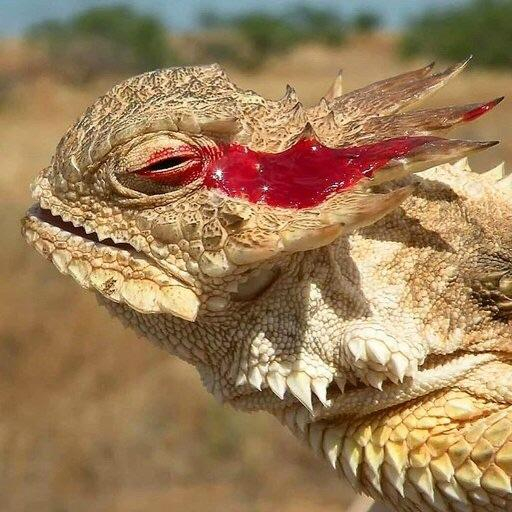In the wild, the horned lizard stands out with its incredible and bizarre defense mechanism: the ability to shoot blood from its eyes. But this isn't just some freak occurrence—it's a carefully evolved survival strategy that helps this small reptile outwit predators and stay alive in some of the harshest environments on Earth.
The Blood-Squirting Defense
When threatened, the horned lizard can build up pressure in its head, inflating its spiky neck, and then, with surprising precision, fire a stream of blood from the ducts near the corners of its eyes. This stream can travel up to three feet and isn't just a random spurt; it’s a carefully aimed shot that can confuse and deter predators. But there's more to this gruesome tactic—the blood has a foul smell, making it even more effective at driving away would-be attackers.
This strategy, however, comes at a cost. The lizard loses up to one-fourth of its blood during the process, so it only resorts to this extreme measure when it feels seriously threatened. Otherwise, it relies on its other unique adaptations to stay safe.
A Living Solar Collector
Beyond its blood-squirting prowess, the horned lizard is also a master at regulating its body temperature. Its large, flat body acts like an inbuilt solar collector. When it's cool, the lizard sprawls out, soaking up the sun's rays to warm up. But when the desert heat becomes too intense, the horned lizard has another trick up its sleeve—it burrows underground. Using a combination of head vibrations and body shimmies, it disappears beneath the surface, escaping the scorching temperatures above.
Camouflage and Spikes
The horned lizard’s spiky appearance isn’t just for show—it’s another layer of defense. These spikes make it difficult for predators to swallow the lizard whole, giving it an edge in survival. Additionally, its coloration helps it blend seamlessly into its desert surroundings, making it hard for predators to spot it in the first place.
10 Other Animals with Strange Survival Mechanisms
The horned lizard isn’t the only animal with bizarre survival tactics. Here are ten more creatures that have developed unusual methods to stay alive in the wild:
-
Bombardier Beetle
- Mechanism: The bombardier beetle can eject a boiling, noxious chemical spray from its abdomen to deter predators. The spray is produced by mixing two chemicals stored separately in its body until needed.
- Survival Benefit: This explosive reaction can ward off predators like spiders and frogs, ensuring the beetle’s survival.
-
Opossum
- Mechanism: When threatened, the opossum plays dead. This act, known as "playing possum," involves lying still, releasing a foul-smelling fluid, and slowing its heart rate to mimic the appearance of a dead and decaying animal.
- Survival Benefit: Many predators prefer live prey, so this convincing act often saves the opossum from being eaten.
-
Pistol Shrimp
- Mechanism: The pistol shrimp has a specialized claw that can snap shut so quickly it creates a cavitation bubble, which collapses to produce a shockwave strong enough to stun or kill prey.
- Survival Benefit: This deadly weapon allows the shrimp to hunt efficiently and defend itself from larger predators.
-
Cuttlefish
- Mechanism: Cuttlefish are masters of camouflage, capable of changing the color, pattern, and even texture of their skin to blend in with their surroundings.
- Survival Benefit: This ability helps them evade predators and sneak up on prey in the diverse and dangerous underwater world.
-
Malaysian Exploding Ant
- Mechanism: Certain ants in Malaysia have the ability to self-destruct by rupturing their own bodies, releasing a sticky, toxic substance that can kill or incapacitate threats.
- Survival Benefit: This sacrificial act protects the colony from intruders, even at the cost of the individual ant's life.
-
Sea Cucumber
- Mechanism: When attacked, some sea cucumbers eject their internal organs out of their anus, which entangles and distracts predators.
- Survival Benefit: The sea cucumber can regenerate these organs, making this a temporary but effective way to escape predators.
-
Hairy Frog
- Mechanism: Also known as the “Wolverine frog,” it can break its own bones to produce claws that puncture through its skin for defense.
- Survival Benefit: This bone-breaking strategy can deter predators, though it comes at a significant cost to the frog.
-
Skunk
- Mechanism: Skunks are notorious for their ability to spray a foul-smelling liquid from their anal glands when threatened.
- Survival Benefit: The odor is so strong that it can cause temporary blindness and nausea, giving the skunk time to escape.
-
Archerfish
- Mechanism: This fish can shoot jets of water to knock insects off branches into the water where it can easily consume them.
- Survival Benefit: By taking down prey from a distance, the archerfish can feed efficiently without expending much energy.
-
Mimic Octopus
- Mechanism: This octopus can imitate the appearance and movements of other marine animals, such as lionfish, flatfish, and sea snakes, to deter predators.
- Survival Benefit: This adaptive mimicry allows the octopus to avoid threats by pretending to be something more dangerous.
The horned lizard's ability to shoot blood from its eyes is just one example of the incredible and sometimes bizarre survival mechanisms found in the animal kingdom. These adaptations highlight the lengths to which nature will go to ensure survival in a world full of predators and environmental challenges. Whether it's the explosive defense of a bombardier beetle or the mimicry of an octopus, these strategies are testaments to the power of evolution and natural selection.
